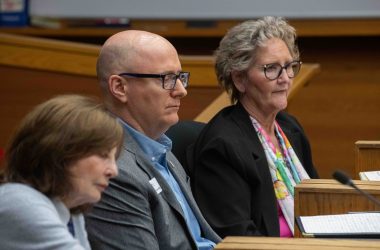
A Salem police car. (Amanda Loman/Salem Reporter)
The Salem Police Department needs more collaboration with community groups, and a formal community-oriented policing plan to spend more time developing relationships with the community.
It also needs to conduct a staffing study and better use its data to direct staffing.
Those are the findings of a draft report assessing the department’s policies, procedures and operations.
The Salem City Council voted to move forward with the outside performance audit of Salem police in July following racial justice protests where some community members accused the department for what they described as uneven enforcement of curfew orders. The findings of that report will be presented to a council work session on March 15.
Hillard Heintze, a security risk management firm based in Chicago that does police department assessments, conducted the audit by interviewing officers and stakeholders, analyzing the department’s technology, mission and values and hosting more than 100 community interviews.
The report advocated for a community policing strategic plan to better coordinate with local resources like nonprofits, social service organizations and school districts.
It said that plan should identify proactive and collaborative responses to repetitive calls for service involving Salem’s unsheltered and at-risk populations.
“Such a plan would address the department’s current inconsistent and uncoordinated efforts,” the report read.
The report found that officers had limited training on how they should interact with unsheltered people or those experiencing behavioral crises.
It said the department should consider mandating all officers participate in Crisis Intervention Team training, a program where police work with mental health professionals. The report noted officers currently receive de-escalation practice through scenarios and as part of their firearms training.
During a police audit steering committee meeting Thursday, police pointed to additional staffing as a need to accomplish “community policing,” or spending more time developing relationships with the community.
For years, the Salem Police Department has lagged in staffing levels below regional and national averages.
It’s a topic that has come up in presentations by former Salem Police Chief Jerry Moore and most recently at the annual State of the City address.
The Salem Police Department is budgeted for 189 full time officers. That accounts for 1.1 officers per 1,000 residents.
For cities with populations between 100,000 to 250,000 the average ratio is 1.6 officers per 1,000, according to FBI data. Nationwide, the rate of sworn officers is 2.4 per 1,000 inhabitants.
In 2010, the department had 97,692 calls for service. That number jumped to 118,344 in 2019, according to the report. In that same period, the sworn staffing level decreased.
Deputy Chief George Burke said a strategic plan is a positive, but officers need to have more unobligated patrol time to accomplish any goals put forth.
“Our community and our city really need to identify what it is that they want our law enforcement agency to be involved in,” Burke told the steering committee. “We’re never going to get there at 1.1 per 1,000 officers. That’s I think the big point behind this conversation. What is it the city wants law enforcement to do?”
One of the key findings in the report is that Salem police don’t regularly analyze their crime and calls for service data to make decisions about where, when and how to use resources.
One interviewee told auditors, “Salem Police Department is an excellent 20th century police department in the 21st century.”
Police Chief Trevor Womack said he would bring the principles of 21st century policing to the department when he applied for the job.
The report said the department can use its data to determine whether community members of color are being policed at a disproportionate rate, to build transparency and to better collaborate with other agencies.
The report gave an example sharing aggregate data about where child abuse crimes occur to help share information with nonprofit agencies working to end child abuse.
“We cannot overstate the importance of using proper data collection and analyses to achieve efficiency in the department. Collecting and analyzing data would help the department enhance safety for law enforcement personnel and community members who work collaboratively with SPD personnel, as well as contribute to improved decision making, situational awareness, productivity, efficiency, transparency and collaboration with partner agencies,” the report said.
The review found that some of the command staff assigned to early protests over the summer had varying perceptions regarding how they were to engage with protestors, which resulted in isolated instances in which they issued conflicting orders to personnel handling crowd control.
It brought up community member concern that officers treated unarmed Black Lives Matter protesters with a heavier hand than armed groups that defended a storefront or right-wing groups that roamed city streets.
The review said that the department needs to improve its policies, training and procedures to respond more effectively to protests.
It also called out a low morale in the department, with only 20% of sworn officers agreeing morale is high. It notes that it reflects what officers are feeling nationwide.
The draft report was released before Superintendent Christy Perry announced that the Salem-Keizer School District would no longer station school resource officers in schools. Those officers have been reassigned to other roles in the Salem Police Department and Marion County Sheriff’s Office.
Officers interviewed for the audit said they wanted more involvement and opportunities to work with youth.
“Many officers interviewed shared stories of how they used to be able to spend time playing sports and engaging in more activities with young people,” it said.
Have a tip? Contact reporter Saphara Harrell at 503-549-6250, [email protected].
Salem Reporter counts on community support to fund vital local journalism. You can help us do more.
SUBSCRIBE: A monthly digital subscription starts at $5 a month.
GIFT: Give someone you know a subscription.
ONE-TIME PAYMENT: Contribute, knowing your support goes towards more local journalism you can trust.









